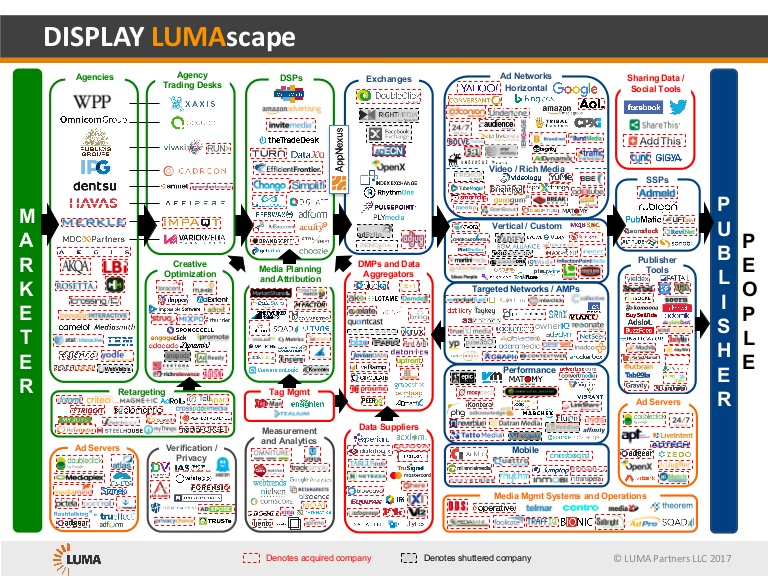 Data is very critical.
Data is very critical.Every ad monetization lead who manages digital advertising faces the same problem: how to aggregate and analyze data across multiple platforms. This task is a complete nightmare.
On average, a publisher’s monetization team spends between 2-3 days a week downloading spreadsheets & compiling data just to have the ability to start analyzing stats and building reports. This has got to be the least favorite part of the ad monetization process. It can be so tedious and most times, confusing.Once all the ad placements & monetization partners are set up, you need to create a dashboard or a spreadsheet where you’re tracking how your key metrics are trending, how individual ad-units are performing and how individual partners are competing.
Updating this dashboard can be time consuming given all the different locations that the data is coming from:
– Website traffic on Google Analytics
– Mobile data from your App analytics partners
– Direct Campaign Data from your ad server
– Header Bidding Data from Prebid and/or your vendor
– Programmatic data from every individual DSP, SSP, Ad Network partner
– DMP data, comscore data, ad verification data, viewability data
– Billing data from your sales management tool
The list goes on and on…
So, when monetization leads find themselves in this position, they either hire people to perform this task or they don’t update the data frequently enough – leading to sub-optimal decisions based on limited data.
But, there is a better way to do this. Tercept fully automates all of this reporting, get’s you started within minutes, elegantly handles unstructured data and allows limitless flexibility for customizations.
Why is Ad Monetization Data Such a Pain?
1. So Many Platforms
It’s kind of overwhelming. There are 100s of ad monetization platforms. Making it nearly impossible to combine data across multiple platforms. How is anyone supposed to report on the overall performance? Look at this ridiculous infographic below..

Tercept has 100+ integrations and was built specifically by AdTech experts, for ad monetization leads to collect all their data, in a granular way.
2. Metrics Definitions & Dimension Members Vary Across Platforms
A metric might be called one thing on one platform, and an entirely different thing on another platform.
A great example is Fill Rate. Google Adx calls it Coverage and defines it as the proportion of Ad Requests for which Adx was able to find a buyer. However, this metric has nothing to do with whether the publisher earned any revenue from the Ad Request. Beyond finding a buyer, Adx records revenue for the publisher only if a final ad was displayed to the user. There are several things that can go wrong between finding a matching buyer and displaying the ad. However, other platforms like Appnexus & Pubmatic calculate fill rate very differently.
Another very common example is Country names. Every publisher has a different approach for country names. What Adx calls USA, Pubmatic calls it United States, Appnexus calls it United States of America, Rubicon calls it U.S.A and Facebook calls it US. It is a nightmare for a monetization lead to aggregate the revenue for USA across all partners.
Tercept automatically maintains consistency across metric definitions & normalizes data across dimension members to ensure a smooth unified experience for the publisher.
3. Everyone Measures Performance Differently
If you have worked with multiple publishers, you’re likely to have seen different ways of performance measurement & analysis. Each publisher will have different requirements for how they choose to measure the effectiveness of their partners & their inventory. Being able to standardize this across all platforms can be challenging.
Page-RPM is one such metric, another is Delivery Rate. Some publishers measure the yield per pageview or screenview as a key metric for the monetization team’s performance. However, this metric has data flowing in from disparate sources and can be challenging to put together on a daily basis. Further, when the publisher is managing multiple properties and measuring a single Page-RPM, the metric needs to be normalized using a weighted avg method, weights being determined by number of sessions or number of users. This can be a highly customized metric where every individual publisher measures it very differently.
Similarly, many of our publishers measure Delivery Rate for Adx. This is the proportion of matched requests for which Google was able to show an ad to the end user and hence accrue revenue for the publisher. This is a very critical metric, but is not readily displayed by Adx reporting.
Tercept allows publishers to easily create a track custom metrics taking away the everyday hassle of downloading reports & preparing specific metrics.
4. Ad Units and Metrics are Evolving Everyday
Platforms are constantly updating the way they measure & report their metrics.
Why? Because ad formats are evolving fast & data is getting more granular. Calculations will continue to change over time. Staying on top of all those changes across the industry is a lot of work. Since there are so many dimensions to monetization data, it becomes difficult to normalize the data across so many platforms.
This is why ad monetization teams have become dependent on manual processes or asking their developers for help aggregating data.
5. Custom Groupings & Labeling/Tagging of Data
Different Publishers have unique audiences and hence end up aggregating & tracking data in unique ways. Take geographic spread for example: Many publishers get traffic from across the globe. So, it becomes important to measure performance by different countries. However, when data becomes sparse for individual countries, you want to bunch up similar performing countries into a group and measure performance of the group as a whole. This can be quite an activity to do on a daily basis. Similarly, you might want to tag a bunch of Ad Units as high-performing Ad Units and some others as low-performing Ad Units and track metrics for these two groups rather than at an individual Ad Unit level.
Again, Tercept has inbuilt functionality to create unlimited number of labels & group your data in various ways so that the dimensions & metrics are exactly customized to your specific requirements.
Stop wasting time in spreadsheets. It’s easy to aggregate your data without the help of developers.
Author
Gourav Chindlur
CEO, Tercept

0 Comments Leave a comment